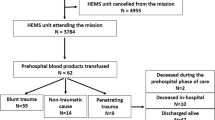Abstract
Purpose
Prehospital transfusions are a novel yet increasingly accepted intervention in the adult population as part of remote damage control resuscitation, but prehospital transfusions remain controversial in children. Our purpose was to review our pediatric prehospital transfusion experience over 12 years to describe the safety of prehospital transfusion in appropriately triaged trauma and nontrauma patients.
Methods
Children (<18 years) transfused with packed red blood cells (pRBC) or plasma during transport to a single regional academic medical center between 2002 and 2014 were identified. Admission details, in-hospital clinical course, and outcomes were analyzed.
Results
28 children were transfused during transport; median age was 8.9 ± 7 years and 15 patients were male (54%). Most patients required at least one additional unit of blood products during their hospitalization (79%), and/or required operative intervention (53%), endoscopy (7%), or died during their hospitalization (14%). Comparison of trauma patients (n = 16) and nontrauma patients (n = 12) revealed that nontrauma patients were younger, more anemic, more coagulopathy on admission, and required more ongoing transfusion in the hospital. Trauma patients were more likely to need operative intervention. No patient had a transfusion reaction.
Conclusion
Remote damage control prehospital transfusions of blood products were safe in this small group of appropriately triaged pediatric patients. Further studies are needed to determine if outcomes are improved and to devise a rigorous protocol for this prehospital intervention for critically ill pediatric patients.

Similar content being viewed by others
References
Holcomb JB, Donathan DP, Cotton BA et al (2015) Prehospital transfusion of plasma and red blood cells in trauma patients. Prehosp Emerg Care 19(1):1–9 (Epub 2014 Jun 16)
Cap AP, Spinella PC, Borgman MA, Blackbourne LH, Perkins JG (2012) Timing and location of blood product transfusion and outcomes in massively transfused combat casualties. J Trauma Acute Care Surg 73:S89–S94
Sunde GA, Vikenes B, Strandenes G et al (2015) Freeze dried plasma and fresh red blood cells for civilian prehospital hemorrhagic shock resuscitation. J Trauma Acute Care Surg 78(6 Suppl 1):S26–S30
Camazine MN, Hemmila MR, Leonard JC et al. (2015) Massive transfusion policies at trauma centers participating in the American College of Surgeons Trauma Quality Improvement Program. J Trauma Acute Care Surg 78(6):S48–S53
Kim BD, Zielinski MD, Jenkins DH, Schiller HJ, Berns KS, Zietlow SP (2012) The effects of prehospital plasma on patients with injury: a prehospital plasma resuscitation. J Trauma Acute Care Surg 73(2 Suppl 1):S49–S53
Moore EE, Chin TL, Chapman MC et al (2014) Plasma first in the field for postinjury hemorrhagic shock. Shock 41(Suppl 1):35–39
Simmons JW, White CE, Eastridge BJ et al (2011) Impact of improved combat casualty care on combat wounded undergoing exploratory laparotomy and massive transfusion. J Trauma 71(1 Suppl):S82–S86
Pieracci FM, Witt J, Moore EE et al (2012) Early death and late morbidity after blood transfusion of injured children: a pilot study. J Pediatr Surg 47:1587–1591
Dehmer JJ, Adamson WT (2010) Massive transfusion and blood product use in the pediatric trauma patient. Semin Pediatr Surg 19:286–291
Chidester SJ, Williams N, Wang W, Groner JI (2012) A pediatric massive transfusion protocol. J Trauma Acute Care Surg 73:1273
Wisner DH, Kuppermann N, Cooper A, Menaker J, Ehrlich P, Kooistra J et al (2015) Management of children with solid organ injuries after blunt torso trauma. J Trauma Acute Care Surg 79(2):206–214
Potter DD, Berns KS, Elsbernd TA, Zietlow SP (2015) Prehospital use of blood and plasma in pediatric trauma patients. Air Med J 34(1):40–43
Hendrickson JE, Shaz BH, Pereira GG et al (2012) Implementation of a pediatric trauma massive transfusion protocol: one institution’s experience. Transfusion 52:1228–1236
Thiels CA, Aho JM, Fahy AS et al (2016) Prehospital blood transfusions in nontrauma patients. World J Surg 40(10):2297–2304
Author information
Authors and Affiliations
Corresponding author
Rights and permissions
About this article
Cite this article
Fahy, A.S., Thiels, C.A., Polites, S.F. et al. Prehospital blood transfusions in pediatric trauma and nontrauma patients: a single-center review of safety and outcomes. Pediatr Surg Int 33, 787–792 (2017). https://doi.org/10.1007/s00383-017-4092-5
Accepted:
Published:
Issue Date:
DOI: https://doi.org/10.1007/s00383-017-4092-5




